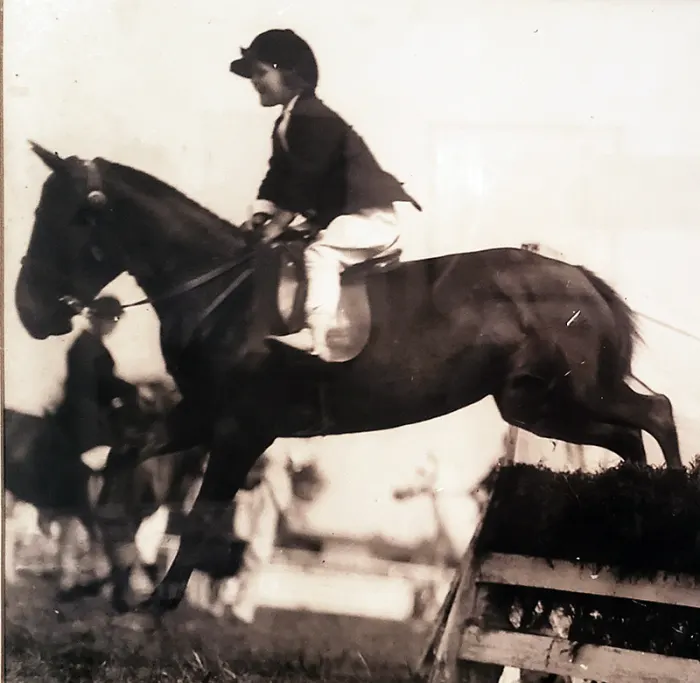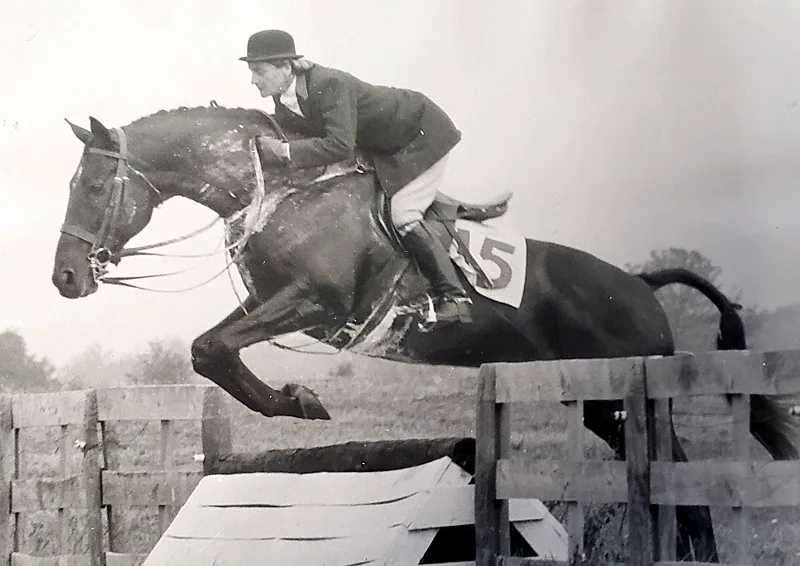Longtime top hunter rider and foxhunter Ellie Wood Baxter died Tuesday, June 13, at her home in Charlottesville, Virginia. She was 101. In 2020, the 1936 Maclay champion shared the following memories about showing from the 1920s through the 1960s and beyond, along with her candid opinions about trends in today’s show world.
No Bad Ponies
Baxter began riding at Keithwood Stables, the busy lesson and livery barn operated for decades by her mother, “Big Ellie Wood” Keith, in Charlottesville.

“I started on ponies, and I never stopped,” says Ellie Wood Baxter, pictured aboard Bessie in 1926. “You can put that in your story: ‘She started on ponies and never stopped!’ “ Photo Courtesy Of Ellie Wood Baxter
Show prep was a little different 90 years ago. “I’m not sure how we made the show ponies jump, because we never had a ring at Keithwood,” Baxter says. “I wonder what all these ponies jumped over at home; I guess it was whatever was put up in the yard! We had a few fences in the yard but nothing like a show ring.
“Mother didn’t believe in starting children on bad ponies,” she recalls. “The ponies I rode, I think that the older children probably rode them, if they needed anything. I never rode a bad pony, and I never rode a bad horse.”
Wintering in Florida was decades away, so hunters often had the winter off or went foxhunting to stay fit. “In the spring, we started showing in the South,” Baxter says. “We’d start somewhere in North Carolina. Then in Virginia we had Staunton, Hot Springs, and I think Keswick and Warrenton. And then we went north.”
Baxter attracted attention with her natural athleticism and feel for a good pace. By the time she reached her teens, owners sought her out to compete their hunters in divisions where professional riders were not allowed: amateur, ladies’ and Corinthian classes. “I’d gotten to be 15, maybe 16,” she recalls. “Because I was a lady, and they had ladies’ classes, different people would ask me to ride their horses.”
The Glory Days Of The Outside Course
With fewer divisions, the competition schedule was less hectic. “The horse shows in my day were wonderful,” Baxter recalls. “Maybe you had to qualify for something about 8 a.m., but it wouldn’t be us, it would be the big team jumper classes.
“We never started in the morning,” she continues. “We started about 1:30 in the afternoon. We’d have a class or two; probably on the first day we’d have a hack class and a jumping class. And then we probably wouldn’t have another class until the next night, say 8:30 at night, maybe two jumping classes.”
She adds, “The hunter classes started at 3’6” and went to 4’, except at some horse shows the stake class would have a 4’6” in-and-out, or one class that was maybe 4’6”. Devon had that. And of course, they all had outside courses.

Known for her accurate eye and forward pace, Ellie Wood Baxter won many classes over outside courses with horses like J. North Fletcher’s Scamp, Jr. at the 1940 Leny Manor Horse and Pony Show (Virginia). Doug Hayes Photo
“Upperville had a wonderful outside course,” Baxter says. “It wasn’t very long. You jumped out of the ring, you went straight out over two big fences, then you turned to the right, and then you went to the in-and-out.”
That in-and-out required some determined riding. “I know it had to be 28’ long,” she says. “So you know when you went into that jump, you were going forward!
“Every time I rode it, I would tell my horse, ‘You better go through this in-and-out in one stride, whether you want to or not!’ and we always did it in one stride,” she continues. “It was a big, 28′ in-and-out. Bigger than 26′, because you can gallop into 26 pretty easily.”
ADVERTISEMENT
New York, New York
Baxter, who was inducted into the National Show Hunter Hall of Fame in 2000, has vivid memories of competing in Madison Square Garden in Manhattan during its glamorous heyday.
“The first big show I went to would have been New York,” she says. “The first time I rode there, somebody was selling a horse, I think. The Irish team had a horse they were selling to someone in this country, and they wanted to show that it was quiet enough for anybody to ride, so I rode it.
“I must have felt wonderful and happy, thrilled to be riding a horse there,” she adds. “It was 1935.” She would have just turned 14 at the time.
Her 1936 Maclay victory came a year before the founding of The Chronicle of the Horse, but Baxter readily provides her own coverage. “I won the Maclay on Big Tip [The Porter—My My, Colin],” she says. “Of course he was a Thoroughbred. We didn’t ride anything but Thoroughbreds.
“He was a good-looking horse; I’d say he was a working hunter,” she adds, noting that there wasn’t a stock of in-demand equitation horses being leased to compete year after year at that time.
Always a fierce competitor, Baxter also recalls her rivals. “We did have some boys in the class. I do remember who I rode off against: Louise Finch, from New Jersey. And I think she was expecting to win!”
While good horsemanship and switching mounts were part of the test 80-some years ago, the courses were far less technical. “We did change horses,” Baxter says. “It wasn’t done so strictly. Our horses weren’t trained at that point to jump courses like they have today. I wouldn’t be surprised if they were just eight jumps around the ring.”
Known for riding forward to the jumps, Baxter improvised to find adequate warm-up space in the tight quarters. “At this time we were in the old Garden, with the horses stabled underneath, and you galloped up a ramp to get them ready,” she says. “I don’t think they’d dare do that today. Anyway, we did! You’d gallop up this ramp, getting their blood warmed up.
“At that point, New York was the only show that had a 4’ hunt team, and everybody showed their best horse,” she continues. “Three on a team. People would bring their horses in from wherever to show them. Some of the show horses that had hunted were in a team, but most of them were brought in somewhere from New Jersey or New York. It was great fun to watch!”
Showing in New York City in the mid-20th century featured unique elegance. “The other thing about the Garden that was fun was they had a little walkaround—a promenade, probably about 10′ wide—where everybody could go all the way out and look in the [reserved] boxes and see who was in the boxes and look at them all dressed in their best,” Baxter recalls. (Her future husband, Charles Baxter, introduced himself by inviting her to spectate from his box). “That was all fun. The other shows never had this.
“Luncheons every day were at the Waldorf-Astoria,” she adds. “After the horse show, there would be a room where they served drinks. Anyway, they didn’t serve me drinks. They served me hot chocolate! I was probably the only one that got it!”

Ellie Wood Baxter was still hunting with Farmington in 2014, often accompanied by local professional Muffin Barnes. Bob Haschart Photo
New York was the finale of the show season before the horses went home for the winter. “All the horses that I rode—and I rode a lot of horses—they were all owned by the people, individuals or Mr.-and-Mrs., and they lived on their owner’s farm,” Ellie Wood says. “We stopped showing after the National Horse Show in November. When I say, ‘we,’ I mean the horses I rode stopped showing. That’s when the hunting started, and we hunted all winter.”
May I Speak To The Manager?
ADVERTISEMENT
Having witnessed many changes in the hunter divisions, Ellie Wood, who received the U.S. Equestrian Federation’s Pegasus Medal of Honor for service to horses and sport, isn’t shy about sharing her opinions.
“I told Joe Fargis the other day—he was over here having lunch with us, and he’s going to be head of the Upperville Horse Show—and I said, ‘Now Joe, if you want to get your horse show back into working hunters, No. 1 you’ve got to change the name [back to working hunters]; No. 2 you’ve got to add ladies’ classes to it. You’ve also got to add a stake class, have a little pace in it,’ ” says Ellie Wood.
“I said, ‘Joe, you want horses [entries] don’t you?’ ” she continues. “Maybe the judges won’t judge it right, but adding these two classes might add more horses to this show, because they might have a horse that will go well for a lady rider, and they might have a horse that has a little pace to it, and it’s a good-looking horse. He’s a pretty horse that can go in the class and compete against these champion horses.
“Anyhow that’s my thought,” she concludes. “Everybody says that the regular rider cannot ride a Thoroughbred. That’s what they say. Now you can’t even find a Thoroughbred, hardly.”

Ellie Wood Baxter rode One War to the open division title at the 1969 Virginia Field Hunter Championship. John J. Carle Jr. Photo
While Ellie Wood doesn’t hesitate to suggest improvements, she is also pragmatic about the industry driving some of the changes.
“I can’t take money away from people,” she replies when asked about the expanding numbers of divisions offering lower fence heights. “I don’t think they belong at horse shows, but what are you going to do?
“They make money, and they make money for people to go out and buy the horse,” she adds. “My goodness, the professional—look how many horses he has to buy nowadays.”
Ellie Wood also praises contemporary riders. “All the good riders today are jumper riders that ride in these big hunter derby classes,” she says. “They’re very good riders. They look well on a horse.”
The Quotable Ellie Wood
Making a good first impression: “There’s nothing worse than having your horse put in a short one at the first jump. You hope you can make up for that mistake, but…!”
Social media: “I do like Facebook. I have a wonderful time. It always takes me 45 minutes when I go to look at it.”
Speed versus pace: “They always said I liked speed, but don’t use that word. Pace was what I was known for, my pace, which I got from foxhunting. Pace is different from speed.”
Interviews: “Of course, I can say anything I want, because nobody else will know what kind of classes were going in 1935!”














